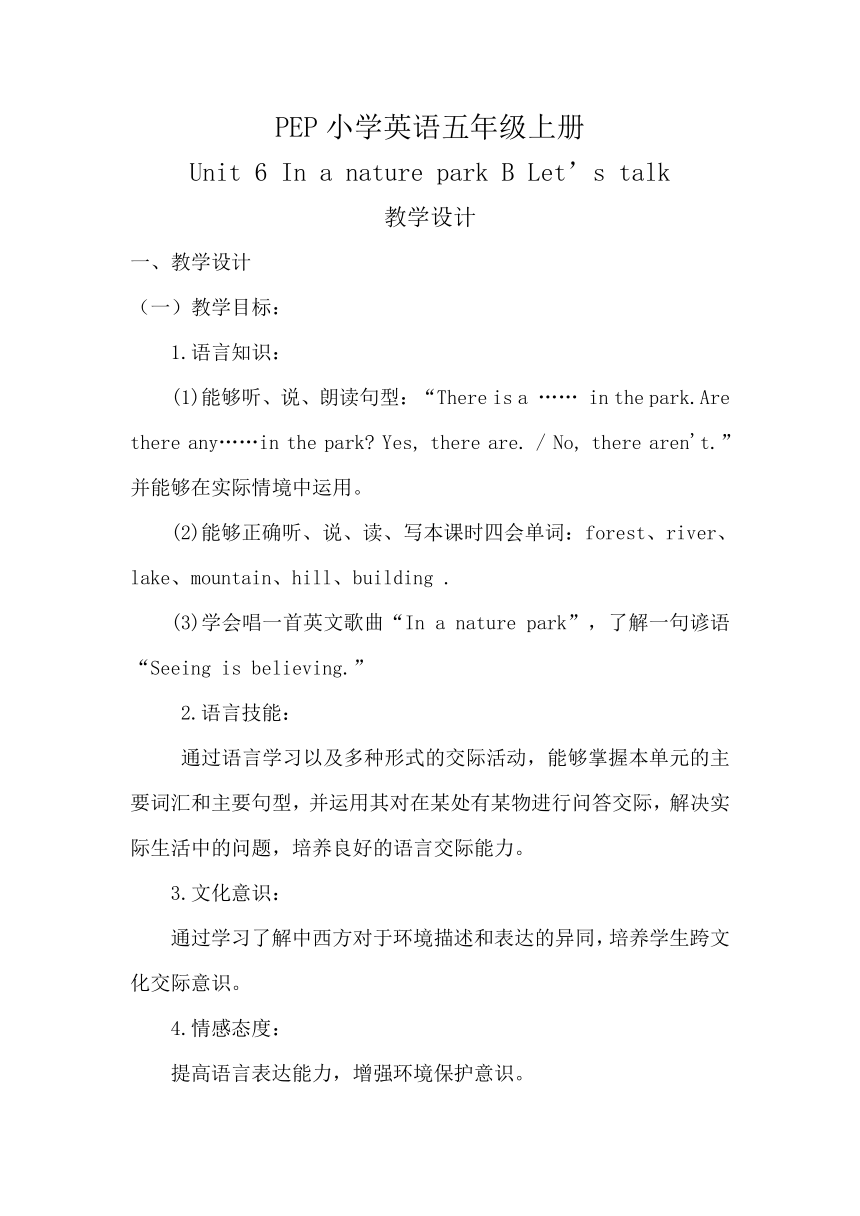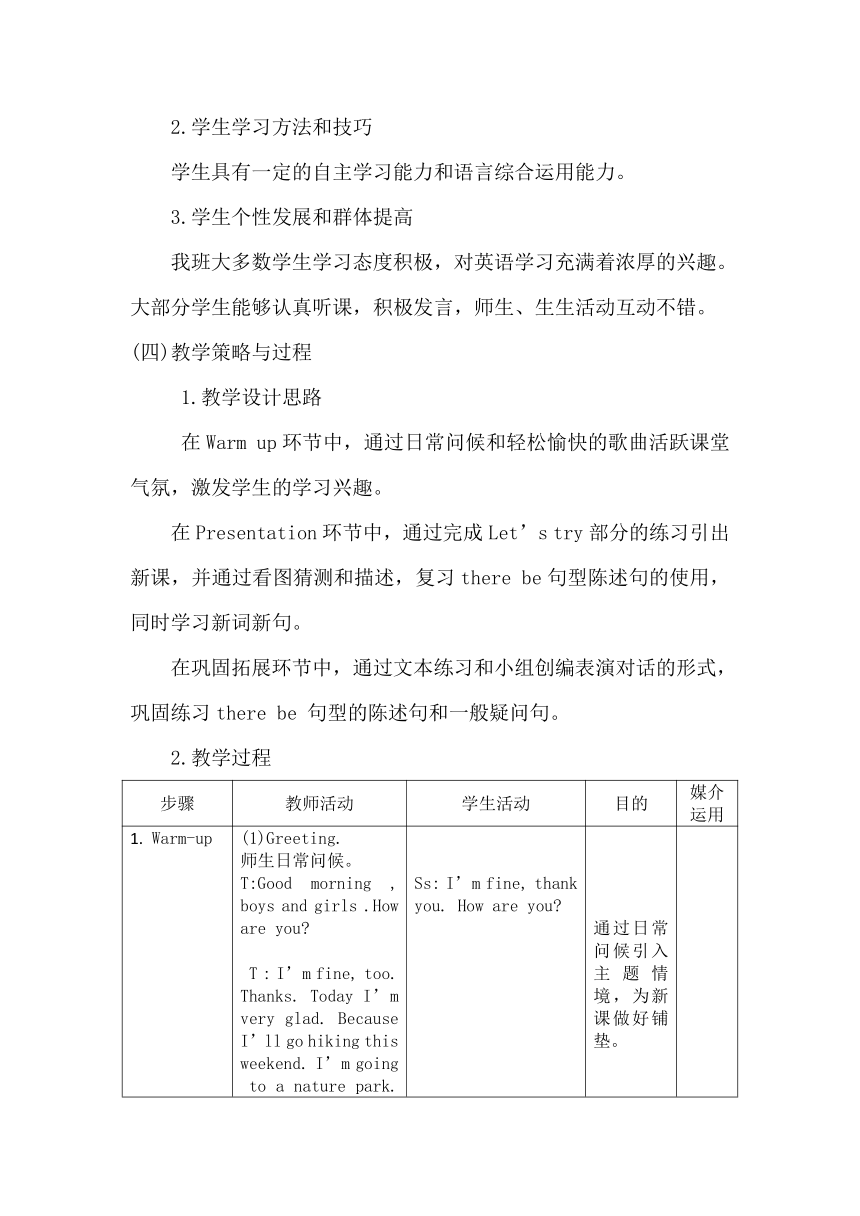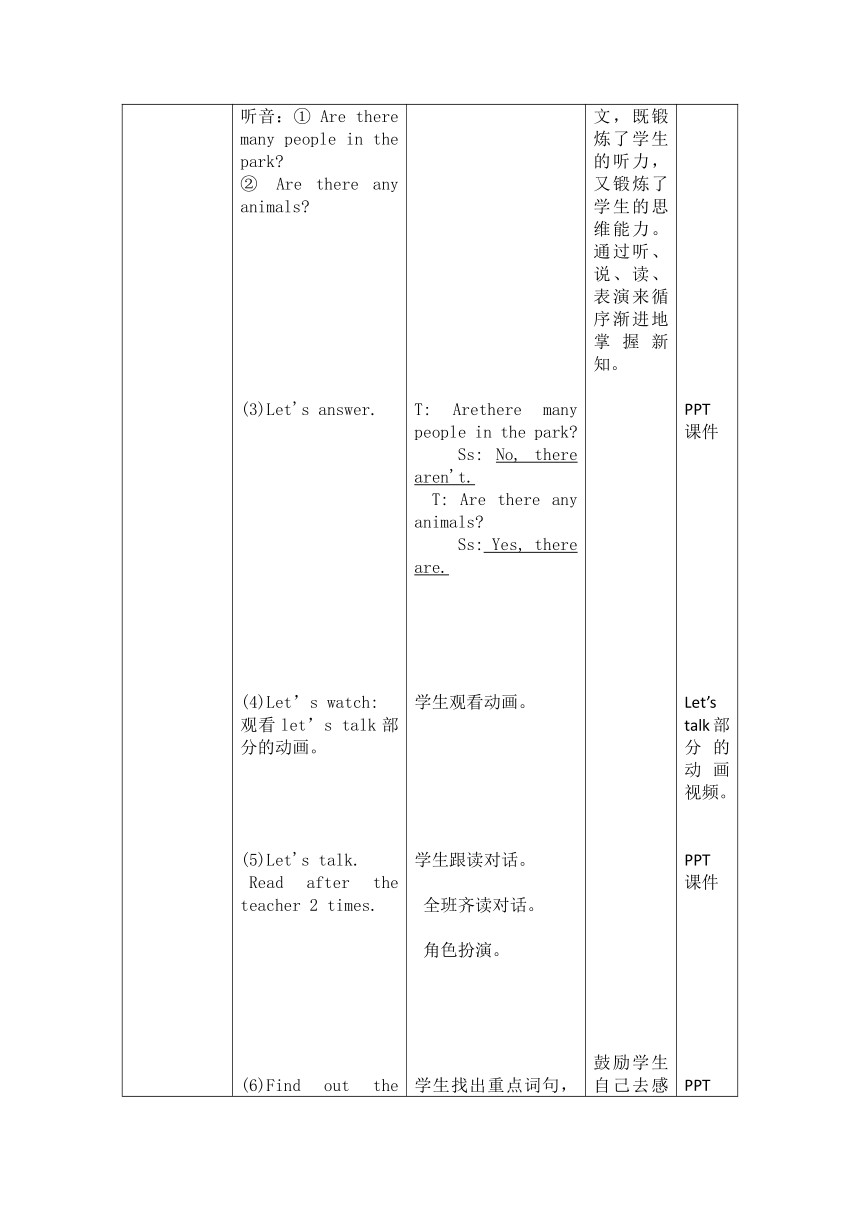Unit 6 In a nature park>Part B 教案
文档属性
| 名称 | Unit 6 In a nature park>Part B 教案 |  | |
| 格式 | zip | ||
| 文件大小 | 16.4KB | ||
| 资源类型 | 教案 | ||
| 版本资源 | 人教版(PEP) | ||
| 科目 | 英语 | ||
| 更新时间 | 2019-11-28 16:11:45 | ||
图片预览





文档简介
PEP小学英语五年级上册
Unit 6 In a nature park B Let’s talk
教学设计
一、教学设计
(一)教学目标:
1.语言知识:
(1)能够听、说、朗读句型:“There is a …… in the park.Are there any……in the park? Yes, there are. / No, there aren't.”并能够在实际情境中运用。
(2)能够正确听、说、读、写本课时四会单词:forest、river、lake、mountain、hill、building .
(3)学会唱一首英文歌曲“In a nature park”,了解一句谚语“Seeing is believing.”
2.语言技能:
通过语言学习以及多种形式的交际活动,能够掌握本单元的主要词汇和主要句型,并运用其对在某处有某物进行问答交际,解决实际生活中的问题,培养良好的语言交际能力。
3.文化意识:
通过学习了解中西方对于环境描述和表达的异同,培养学生跨文化交际意识。
4.情感态度:
提高语言表达能力,增强环境保护意识。
5.学习策略:
能够在情景中进行真实交际;能够自主阅读并通过小组合作总结有效的学习方法。
(二)教学内容分析
1.教材内容的地位、作用与意义:
本课教学内容为PEP小学五年级上册Unit 6 In a nature park B Let’s talk。对话部分是单元的核心内容,是教材教学目标的导向,旨在引导教师组织学生完成对话理解、朗读表演任务后,还要提供与学生现实生活有联系的语言交流活动,帮助学生通过参与活动,有效地把语言知识转化为语言能力。
2.教材的编排特点、重点和难点:
教材编排特点:强调语言运用,注重能力培养,突出兴趣激发,重视双向交流和灵活扩展。
重点:掌握句型:“Are there any…?”及其肯定回答:“Yes, there are.”否定回答:“No, there aren't.”
难点:在“Are there any…?”句型中正确运用any;在实际情境中灵活运用以上句型获取信息。
(三)教学对象分析
1.学生已有知识和经验
本课教学的对象是五年级上学期的学生。通过三年级和四年级的学习,他们已经掌握了一些对话和一定的词汇量,能听懂一些课堂用语,并能有序地参与课堂游戏活动。
2.学生学习方法和技巧
学生具有一定的自主学习能力和语言综合运用能力。
3.学生个性发展和群体提高
我班大多数学生学习态度积极,对英语学习充满着浓厚的兴趣。大部分学生能够认真听课,积极发言,师生、生生活动互动不错。
(四)教学策略与过程
1.教学设计思路
在Warm up环节中,通过日常问候和轻松愉快的歌曲活跃课堂气氛,激发学生的学习兴趣。
在Presentation环节中,通过完成Let’s try部分的练习引出新课,并通过看图猜测和描述,复习there be句型陈述句的使用,同时学习新词新句。
在巩固拓展环节中,通过文本练习和小组创编表演对话的形式,巩固练习there be 句型的陈述句和一般疑问句。
2.教学过程
步骤
教师活动
学生活动
目的
媒介运用
1. Warm-up
(1)Greeting.
师生日常问候。
T:Good morning , boys and girls .How are you?
T : I’m fine, too. Thanks. Today I’m very glad. Because I’ll go hiking this weekend. I’m going
to a nature park. Do you want to go with me?
(2)Sing a song:“In a nature park”
(3)Questions: What’s in the park?
出示公园图片,指名学生回答。
T: Are there any tall buildings? No, there aren't.让学生初步感知there be句型复数句的一般疑问句。理解building,师带读building 。
Ss: I’m fine, thank you. How are you?
Ss: Yes.
全班齐唱歌曲。
学生看图回答:There is …/There are…;Is there …?Yes there is. /No,there isn’t.Are there …? Yes, there are. /No,there aren’t.
学生跟读新词building。
通过日常问候引入主题情境,为新课做好铺垫。
通过轻松的歌曲,活跃课堂气氛。
复习学过的单词和句子,为新授做好铺垫。
歌曲动画视频。
PPT课件
PPT课件。
2.
Presentation
(1)Let's try: Where are the tables?
(2)Let's listen.
让学生带着问题听音:① Are there many people in the park?
② Are there any animals?
(3)Let's answer.
(4)Let’s watch:
观看let’s talk部分的动画。
(5)Let's talk.
Read after the teacher 2 times.
(6)Find out the important words and the key sentences.
(7)教师点拨:Key points: 询问某地是否有某物或某人:Are there any…? Yes, there are. / No, there aren't.
Some用于肯定句,any用于一般疑问句或否定句。
学生听两遍,然后回答:
The tables are beside the lake.
学生认真听录音。
T: Arethere many people in the park?
Ss: No, there aren't.
T: Are there any animals?
Ss: Yes, there are.
学生观看动画。
学生跟读对话。
全班齐读对话。
角色扮演。
学生找出重点词句,并汇报。
Words: aren't =are not building: 建筑物 any: 任何的
Sentences: Are there any tall buildings in the nature park?No, there aren't. Are there any animals? Yes, there are.
听力练习锻炼了学生们在语段中寻找关键点的能力。
带着问题去听课文,既锻炼了学生的听力,又锻炼了学生的思维能力。通过听、说、读、表演来循序渐进地掌握新知。
鼓励学生自己去感知、发现本课的核心词句。
帮助学生归纳本课知识点。
Let’s try部分的音频。
PPT课件
PPT课件
Let’s talk部分的动画视频。
PPT课件
PPT课件
PPT课件
3.Consolidation
(1)Read and fill in the blanks:
Task 1:
Zhang Peng: The nature park is so quiet!
Miss White: Yes,Zhang Peng.There aren't many people.
Zhang Peng:____
____________?
Miss White: No,there aren't.
Zhang Peng:___
___________?
Miss White: Yes, there are.There are ducks and rabbits.
Task 2:
Zhang Peng: The nature park is so quiet!
Miss White: Yes, Zhang Peng.There aren't many people.
Zhang Peng:___
__________?
Miss White:___
___________.
Zhang Peng:____
___________?
Miss White:____
_________. There are ducks and rabbits.
(2)Choose the right answer.
①—Is there a bird in the sky?
-- __________
A. Yes, there are. B.Yes, there is. C. Yes, there isn't.
② There____ some pictures on the wall.
A. are B. is C. have
③ There aren't
_____ people in the park.
A.some B. a C. any
④—Are there many animals in the river?
--____________
A. Yes,there is. B. No,there are. C.Yes,there are.
⑤Are there ___
bridges in your village?
A.some B. any C. a
(3)Writing.
Look at the picture,write three sentences.
T: The sky is blue. The water is clean. The trees are green.The air is fresh. So we must protect the environment.
(4)微课形式示范对话
Amy: This village is nice!
Miss White: Yes, Amy. And it’s big and quiet!There are many people here.
Amy: Are there any houses in the village?
Miss White: Yes, there are.
Amy: Are there any tall buildings?
Miss White: No, there aren't.
Chen Jie: Are there many trees?
Miss White: Yes, there are many big trees. Look, there’s a big mouse beside the tree.
Amy&Chen Jie : Oh, no!
(5)Let’s practice.
Act out the new dialogue with your partners.
指名学生回答。
指名学生回答。
学生完成看图写话。
学生完成练习后,指名学生回答,集体核对答案。
学生观看对话。
小组上台表演新编的对话。
Task1和Task2的任务里挖空对话中的重点句型让学生填空,检查学生对新课的掌握程度。
通过练习检查学生对there be句型及some,any的用法的掌握程度。
通过看图写话环节,对学生进行爱护环境的教育。
通过小组合作创编对话,巩固练习there be 句型的陈述句和一般疑问句,加强学生们对句型的掌握,把所学句型运用于生活,达到学于致用的目的
培养学生在情景中进行真实交际的能力。
。
PPT课件
PPT课件
PPT课件
微课视频示范。
4.Summary
T: What did we learn today?
(2)Proverb
Seeing is believing. 眼见为实。
T:I believe you will succeed in the future.
指名学生归纳总结。
教师引导学生进行课堂小结,既是对本课内容的复习,又是为下节课做铺垫。同时充分体现学生的主体地位,增强学生的自我综合能力。
鼓励学生努力学习,将来一定会成功的。
PPT课件
PPT课件
5. Homework
(1)Listen and read after the tape three times.
(2) Act out the new dialogue with your classmates.
PPT课件
板书设计:
Unit 6 In a nature park
B Let’s talk
Are there any…?
Yes, there are. / No, there aren't.
(五)教学评价
本节课教师课前准备充分,制作精美实用的PPT课件和微课,充分调动了学生的学习积极性。
本课时教学环节紧凑,重、难点突出。学生朗读能力强,教师注意到了语音语调的教学。教师能大胆放手让学生自主学习,如:由学生自主找出对话中的重、难点,自己去归纳总结本课时的内容,说明学生能力强,教师平时引导好,使学生形成好的学习思维习惯。
整节课教师能注重对学生的听、说、读、写的锻炼。活动过程中师生互动、生生互动做得较好,课堂气氛活跃,达到了预定的教学效果。
二、教学反思:
本节课围绕nature park展开话题,重点学习there be句型的一般疑问句复数形式及其肯定、否定回答,要求学生在掌握四会单词building和缩写式aren't的基础上能够对周围的自然环境进行简单描述、询问并作答。能够对风景图片进行简单对话并看图写话等。
亮点:
1、设计Writing环节,让学生在听、说、读的基础上完成写作练习,把知识落实到笔头上,既锻炼了学生写的基本技能,又将知识落实到实处,掌握基本技能。
2、创设情境,利用微课形式示范对话,让学生围绕小组创作的图画内容创编对话,微课的运用引起学生们的好奇心,激发了他们的热情和表演欲望,为学生创造了一个运用语言的平台,让学生们在交际过程中拓展所学知识,将语言知识进行融合,锻炼了学生们综合运用语言的能力。
不足之处:
1、通过设计周末将去自然公园郊游的情境,让学生齐唱歌曲“In a nature park”,边唱边感受自然公园的美丽,为下面的学习做好铺垫。通过出示公园图片,用“What’s in the park?”引导学生看图回答There is…/There are…由于出示的图片不够清晰,内容不够丰富,学生们不能很快反应到有什么东西,故There be句型的肯定句操练面积不大,同时由于担心后面的练习时间不够,所以我没有利用好ALet's talk的句型:Is there…? Yes, there is ./ No, there isn’t. 而是直接利用课文对话:Are there any tall buildings? No, there aren't.带入新课,显得较为仓促。
2、Writing环节:学生通过图片运用所学语言写出3句话,指名3位同学上台展示,在展示时间,我可以选一位学生代表上台,跟其他同学一起做小老师来判断所写句子的正误,而不是一味自己包办代替。要充分放手学生,培养学生大胆协作和组织判断的能力。
Unit 6 In a nature park B Let’s talk
教学设计
一、教学设计
(一)教学目标:
1.语言知识:
(1)能够听、说、朗读句型:“There is a …… in the park.Are there any……in the park? Yes, there are. / No, there aren't.”并能够在实际情境中运用。
(2)能够正确听、说、读、写本课时四会单词:forest、river、lake、mountain、hill、building .
(3)学会唱一首英文歌曲“In a nature park”,了解一句谚语“Seeing is believing.”
2.语言技能:
通过语言学习以及多种形式的交际活动,能够掌握本单元的主要词汇和主要句型,并运用其对在某处有某物进行问答交际,解决实际生活中的问题,培养良好的语言交际能力。
3.文化意识:
通过学习了解中西方对于环境描述和表达的异同,培养学生跨文化交际意识。
4.情感态度:
提高语言表达能力,增强环境保护意识。
5.学习策略:
能够在情景中进行真实交际;能够自主阅读并通过小组合作总结有效的学习方法。
(二)教学内容分析
1.教材内容的地位、作用与意义:
本课教学内容为PEP小学五年级上册Unit 6 In a nature park B Let’s talk。对话部分是单元的核心内容,是教材教学目标的导向,旨在引导教师组织学生完成对话理解、朗读表演任务后,还要提供与学生现实生活有联系的语言交流活动,帮助学生通过参与活动,有效地把语言知识转化为语言能力。
2.教材的编排特点、重点和难点:
教材编排特点:强调语言运用,注重能力培养,突出兴趣激发,重视双向交流和灵活扩展。
重点:掌握句型:“Are there any…?”及其肯定回答:“Yes, there are.”否定回答:“No, there aren't.”
难点:在“Are there any…?”句型中正确运用any;在实际情境中灵活运用以上句型获取信息。
(三)教学对象分析
1.学生已有知识和经验
本课教学的对象是五年级上学期的学生。通过三年级和四年级的学习,他们已经掌握了一些对话和一定的词汇量,能听懂一些课堂用语,并能有序地参与课堂游戏活动。
2.学生学习方法和技巧
学生具有一定的自主学习能力和语言综合运用能力。
3.学生个性发展和群体提高
我班大多数学生学习态度积极,对英语学习充满着浓厚的兴趣。大部分学生能够认真听课,积极发言,师生、生生活动互动不错。
(四)教学策略与过程
1.教学设计思路
在Warm up环节中,通过日常问候和轻松愉快的歌曲活跃课堂气氛,激发学生的学习兴趣。
在Presentation环节中,通过完成Let’s try部分的练习引出新课,并通过看图猜测和描述,复习there be句型陈述句的使用,同时学习新词新句。
在巩固拓展环节中,通过文本练习和小组创编表演对话的形式,巩固练习there be 句型的陈述句和一般疑问句。
2.教学过程
步骤
教师活动
学生活动
目的
媒介运用
1. Warm-up
(1)Greeting.
师生日常问候。
T:Good morning , boys and girls .How are you?
T : I’m fine, too. Thanks. Today I’m very glad. Because I’ll go hiking this weekend. I’m going
to a nature park. Do you want to go with me?
(2)Sing a song:“In a nature park”
(3)Questions: What’s in the park?
出示公园图片,指名学生回答。
T: Are there any tall buildings? No, there aren't.让学生初步感知there be句型复数句的一般疑问句。理解building,师带读building 。
Ss: I’m fine, thank you. How are you?
Ss: Yes.
全班齐唱歌曲。
学生看图回答:There is …/There are…;Is there …?Yes there is. /No,there isn’t.Are there …? Yes, there are. /No,there aren’t.
学生跟读新词building。
通过日常问候引入主题情境,为新课做好铺垫。
通过轻松的歌曲,活跃课堂气氛。
复习学过的单词和句子,为新授做好铺垫。
歌曲动画视频。
PPT课件
PPT课件。
2.
Presentation
(1)Let's try: Where are the tables?
(2)Let's listen.
让学生带着问题听音:① Are there many people in the park?
② Are there any animals?
(3)Let's answer.
(4)Let’s watch:
观看let’s talk部分的动画。
(5)Let's talk.
Read after the teacher 2 times.
(6)Find out the important words and the key sentences.
(7)教师点拨:Key points: 询问某地是否有某物或某人:Are there any…? Yes, there are. / No, there aren't.
Some用于肯定句,any用于一般疑问句或否定句。
学生听两遍,然后回答:
The tables are beside the lake.
学生认真听录音。
T: Arethere many people in the park?
Ss: No, there aren't.
T: Are there any animals?
Ss: Yes, there are.
学生观看动画。
学生跟读对话。
全班齐读对话。
角色扮演。
学生找出重点词句,并汇报。
Words: aren't =are not building: 建筑物 any: 任何的
Sentences: Are there any tall buildings in the nature park?No, there aren't. Are there any animals? Yes, there are.
听力练习锻炼了学生们在语段中寻找关键点的能力。
带着问题去听课文,既锻炼了学生的听力,又锻炼了学生的思维能力。通过听、说、读、表演来循序渐进地掌握新知。
鼓励学生自己去感知、发现本课的核心词句。
帮助学生归纳本课知识点。
Let’s try部分的音频。
PPT课件
PPT课件
Let’s talk部分的动画视频。
PPT课件
PPT课件
PPT课件
3.Consolidation
(1)Read and fill in the blanks:
Task 1:
Zhang Peng: The nature park is so quiet!
Miss White: Yes,Zhang Peng.There aren't many people.
Zhang Peng:____
____________?
Miss White: No,there aren't.
Zhang Peng:___
___________?
Miss White: Yes, there are.There are ducks and rabbits.
Task 2:
Zhang Peng: The nature park is so quiet!
Miss White: Yes, Zhang Peng.There aren't many people.
Zhang Peng:___
__________?
Miss White:___
___________.
Zhang Peng:____
___________?
Miss White:____
_________. There are ducks and rabbits.
(2)Choose the right answer.
①—Is there a bird in the sky?
-- __________
A. Yes, there are. B.Yes, there is. C. Yes, there isn't.
② There____ some pictures on the wall.
A. are B. is C. have
③ There aren't
_____ people in the park.
A.some B. a C. any
④—Are there many animals in the river?
--____________
A. Yes,there is. B. No,there are. C.Yes,there are.
⑤Are there ___
bridges in your village?
A.some B. any C. a
(3)Writing.
Look at the picture,write three sentences.
T: The sky is blue. The water is clean. The trees are green.The air is fresh. So we must protect the environment.
(4)微课形式示范对话
Amy: This village is nice!
Miss White: Yes, Amy. And it’s big and quiet!There are many people here.
Amy: Are there any houses in the village?
Miss White: Yes, there are.
Amy: Are there any tall buildings?
Miss White: No, there aren't.
Chen Jie: Are there many trees?
Miss White: Yes, there are many big trees. Look, there’s a big mouse beside the tree.
Amy&Chen Jie : Oh, no!
(5)Let’s practice.
Act out the new dialogue with your partners.
指名学生回答。
指名学生回答。
学生完成看图写话。
学生完成练习后,指名学生回答,集体核对答案。
学生观看对话。
小组上台表演新编的对话。
Task1和Task2的任务里挖空对话中的重点句型让学生填空,检查学生对新课的掌握程度。
通过练习检查学生对there be句型及some,any的用法的掌握程度。
通过看图写话环节,对学生进行爱护环境的教育。
通过小组合作创编对话,巩固练习there be 句型的陈述句和一般疑问句,加强学生们对句型的掌握,把所学句型运用于生活,达到学于致用的目的
培养学生在情景中进行真实交际的能力。
。
PPT课件
PPT课件
PPT课件
微课视频示范。
4.Summary
T: What did we learn today?
(2)Proverb
Seeing is believing. 眼见为实。
T:I believe you will succeed in the future.
指名学生归纳总结。
教师引导学生进行课堂小结,既是对本课内容的复习,又是为下节课做铺垫。同时充分体现学生的主体地位,增强学生的自我综合能力。
鼓励学生努力学习,将来一定会成功的。
PPT课件
PPT课件
5. Homework
(1)Listen and read after the tape three times.
(2) Act out the new dialogue with your classmates.
PPT课件
板书设计:
Unit 6 In a nature park
B Let’s talk
Are there any…?
Yes, there are. / No, there aren't.
(五)教学评价
本节课教师课前准备充分,制作精美实用的PPT课件和微课,充分调动了学生的学习积极性。
本课时教学环节紧凑,重、难点突出。学生朗读能力强,教师注意到了语音语调的教学。教师能大胆放手让学生自主学习,如:由学生自主找出对话中的重、难点,自己去归纳总结本课时的内容,说明学生能力强,教师平时引导好,使学生形成好的学习思维习惯。
整节课教师能注重对学生的听、说、读、写的锻炼。活动过程中师生互动、生生互动做得较好,课堂气氛活跃,达到了预定的教学效果。
二、教学反思:
本节课围绕nature park展开话题,重点学习there be句型的一般疑问句复数形式及其肯定、否定回答,要求学生在掌握四会单词building和缩写式aren't的基础上能够对周围的自然环境进行简单描述、询问并作答。能够对风景图片进行简单对话并看图写话等。
亮点:
1、设计Writing环节,让学生在听、说、读的基础上完成写作练习,把知识落实到笔头上,既锻炼了学生写的基本技能,又将知识落实到实处,掌握基本技能。
2、创设情境,利用微课形式示范对话,让学生围绕小组创作的图画内容创编对话,微课的运用引起学生们的好奇心,激发了他们的热情和表演欲望,为学生创造了一个运用语言的平台,让学生们在交际过程中拓展所学知识,将语言知识进行融合,锻炼了学生们综合运用语言的能力。
不足之处:
1、通过设计周末将去自然公园郊游的情境,让学生齐唱歌曲“In a nature park”,边唱边感受自然公园的美丽,为下面的学习做好铺垫。通过出示公园图片,用“What’s in the park?”引导学生看图回答There is…/There are…由于出示的图片不够清晰,内容不够丰富,学生们不能很快反应到有什么东西,故There be句型的肯定句操练面积不大,同时由于担心后面的练习时间不够,所以我没有利用好ALet's talk的句型:Is there…? Yes, there is ./ No, there isn’t. 而是直接利用课文对话:Are there any tall buildings? No, there aren't.带入新课,显得较为仓促。
2、Writing环节:学生通过图片运用所学语言写出3句话,指名3位同学上台展示,在展示时间,我可以选一位学生代表上台,跟其他同学一起做小老师来判断所写句子的正误,而不是一味自己包办代替。要充分放手学生,培养学生大胆协作和组织判断的能力。
